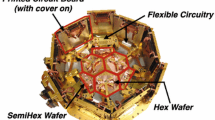Abstract
Advanced ACTPol is a polarization-sensitive upgrade for the 6 m aperture Atacama Cosmology Telescope, adding new frequencies and increasing sensitivity over the previous ACTPol receiver. In 2016, Advanced ACTPol will begin to map approximately half the sky in five frequency bands (28–230 GHz). Its maps of primary and secondary cosmic microwave background anisotropies—imaged in intensity and polarization at few arcminute-scale resolution—will enable precision cosmological constraints and also a wide array of cross-correlation science that probes the expansion history of the universe and the growth of structure via gravitational collapse. To accomplish these scientific goals, the Advanced ACTPol receiver will be a significant upgrade to the ACTPol receiver, including four new multichroic arrays of cryogenic, feedhorn-coupled AlMn transition edge sensor polarimeters (fabricated on 150 mm diameter wafers); a system of continuously rotating meta-material silicon half-wave plates; and a new multiplexing readout architecture which uses superconducting quantum interference devices and time division to achieve a 64-row multiplexing factor. Here we present the status and scientific goals of the Advanced ACTPol instrument, emphasizing the design and implementation of the Advanced ACTPol cryogenic detector arrays.



Similar content being viewed by others
References
M.D. Niemack et al., Proc. SPIE 7741, 77411S (2010)
P.A.R. Ade et al., Astrophys. J. 792, 62 (2014). doi:10.1088/0004-637X/792/1/62
Z. Staniszewski et al., J. Low Temp. Phys. 167, 827 (2012). doi:10.1007/s10909-012-0510-1
K. Arnold et al., Proc. SPIE 7741, 77411E (2010)
J.E. Austermann et al., Proc. SPIE 8452, 84521E (2012)
W. Grainger et al., Proc. SPIE 7020, 70202N (2008)
A. Fraisse et al., JCAP 2013(04), 047 (2013). doi:10.1088/1475-7516/2013/04/047
J.A. Tauber et al., A&A 520, A1 (2010). doi:10.1051/0004-6361/200912983
T. Essinger-Hileman et al., Proc. SPIE 9153, 91531I (2014)
S. Galli et al., Phys. Rev. D 90, 063504 (2014). doi:10.1103/PhysRevD.90.063504
E. Calabrese et al., JCAP 2014(08), 010 (2014). doi:10.1088/1475-7516/2014/08/010
D. Hanson et al., Phys. Rev. Lett. 111, 141301 (2013). doi:10.1103/PhysRevLett.111.141301
P.A.R. Ade et al., Phys. Rev. Lett. 112, 241101 (2014). doi:10.1103/PhysRevLett.112.241101
S. Naess et al., JCAP 10, 007 (2014). doi:10.1088/1475-7516/2014/10/007
M. Madhavacheril et al., Phys. Rev. Lett. 114, 151302 (2015). doi:10.1103/PhysRevLett.114.151302
R. Allison et al., MNRAS 451, 849 (2015). doi:10.1093/mnras/stv991
A. van Engelen et al., Astrophys. J. 808(1), 7 (2015). doi:10.1088/0004-637X/808/1/7
E. Grace et al., Proc. SPIE 9153, 915310 (2014)
S.P. Ho, et al., In this Special Issue LTD16 in J. Low Temp. Phys
R. Datta et al., In this Special Issue LTD16 in J. Low Temp. Phys
J. Delabrouille et al., A&A 553, A96 (2013). doi:10.1051/0004-6361/201220019
J.E. Carlstrom, G.P. Holder, E.D. Reese, Annu. Rev. Astron. Astrophys. 40, 643 (2002). doi:10.1146/annurev.astro.40.060401.093803
E.-M. Mueller et al., Phys. Rev. D 92, 063501 (2015). doi:10.1103/PhysRevD.92.063501
K.M. Smith et al., AIP Conf. Proc. 1141(1), 121 (2009)
Z. Ivezic et al., arXiv:0805.2366 (2008)
S. Miyazaki et al., Proc. SPIE 6269, 62690B (2006)
B.L. Flaugher et al., Proc. SPIE 8446, 844611 (2012)
A. Merloni et al., arXiv:1209.3114 (2012)
K.S. Dawson et al., Astron. J. 145, 10 (2013). doi:10.1088/0004-6256/145/1/10
M. Levi et al., arXiv:1308.0847 (2013)
D.S. Swetz et al., Astrophys. J. Suppl. Ser. 194(2), 41 (2011). doi:10.1088/0067-0049/194/2/41
A. Kusaka et al., Rev. Sci. Instrum. 85(2), 024501 (2014). doi:10.1063/1.4862058
S. Hanany et al., Appl. Opt. 44(22), 4666 (2005). doi:10.1364/AO.44.004666
D. Li et al., In this Special Issue LTD16 in J. Low Temp. Phys
R. Datta et al., Appl. Opt. 52(36), 8747 (2013). doi:10.1364/AO.52.008747
R. Datta et al., J. Low Temp. Phys. 176(5–6), 670 (2014). doi:10.1007/s10909-014-1134-4
S. Duff et al., In this Special Issue LTD16 in J. Low Temp. Phys
S.W. Deiker et al., Appl. Phys. Lett. 85(11), 2137 (2004). doi:10.1063/1.1789575
J. Austermann et al., In this Special Issue LTD16 in J. Low Temp. Phys
E. Battistelli et al., J. Low Temp. Phys. 151(3–4), 908 (2008). doi:10.1007/s10909-008-9772-z
W.S. Holland et al., MNRAS 430, 2513 (2013). doi:10.1093/mnras/sts612
J. Beyer, D. Drung, Supercond. Sci. Technol. 21(10), 105022 (2008)
R. Doriese et al., In this Special Issue LTD16 in J. Low Temp. Phys
C. Pappas et al., In this Special Issue LTD16 in J. Low Temp. Phys
Acknowledgments
This work was supported by the U.S. National Science Foundation through Awards 1312380 and 1440226. The NIST authors would like to acknowledge the support of the NIST Quantum Initiative. The development of multichroic detectors and lenses was supported by NASA Grants NNX13AE56G and NNX14AB58G. The work of KPC, KTC, EG, BJK, CM, BLS, JTW, and SMS was supported by NASA Space Technology Research Fellowship awards.
Author information
Authors and Affiliations
Corresponding author
Rights and permissions
About this article
Cite this article
Henderson, S.W., Allison, R., Austermann, J. et al. Advanced ACTPol Cryogenic Detector Arrays and Readout. J Low Temp Phys 184, 772–779 (2016). https://doi.org/10.1007/s10909-016-1575-z
Received:
Accepted:
Published:
Issue Date:
DOI: https://doi.org/10.1007/s10909-016-1575-z




